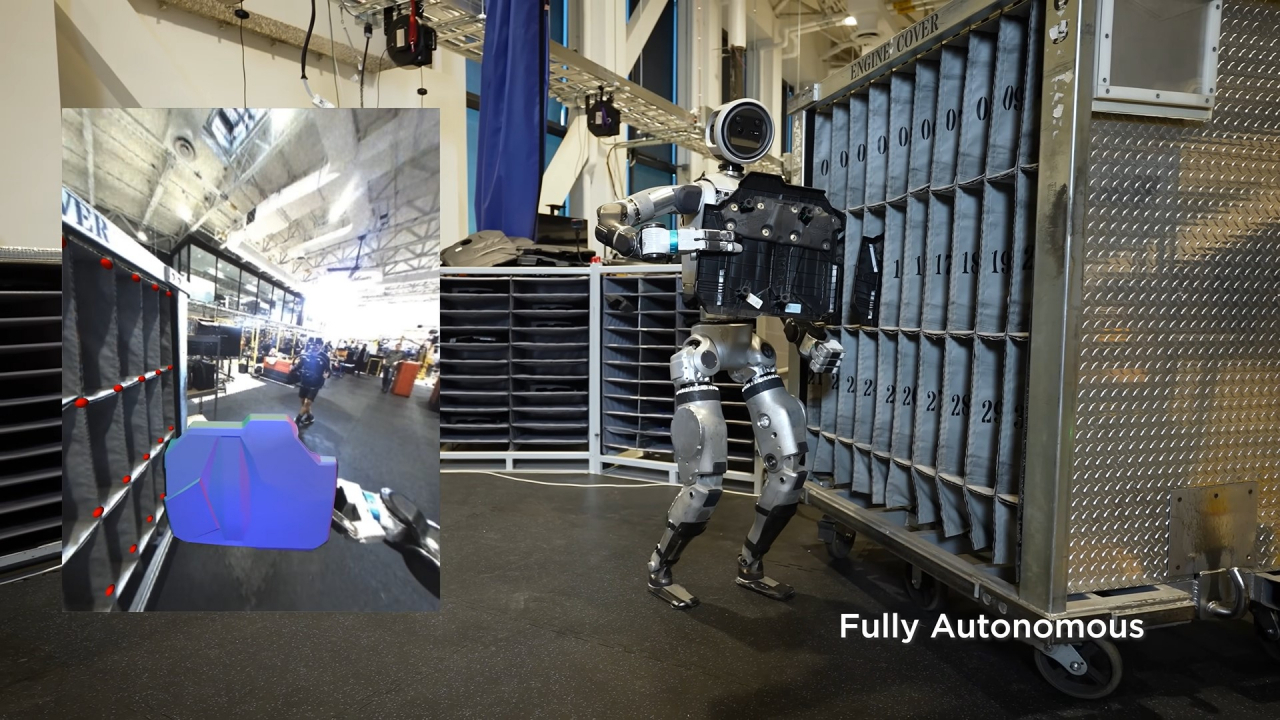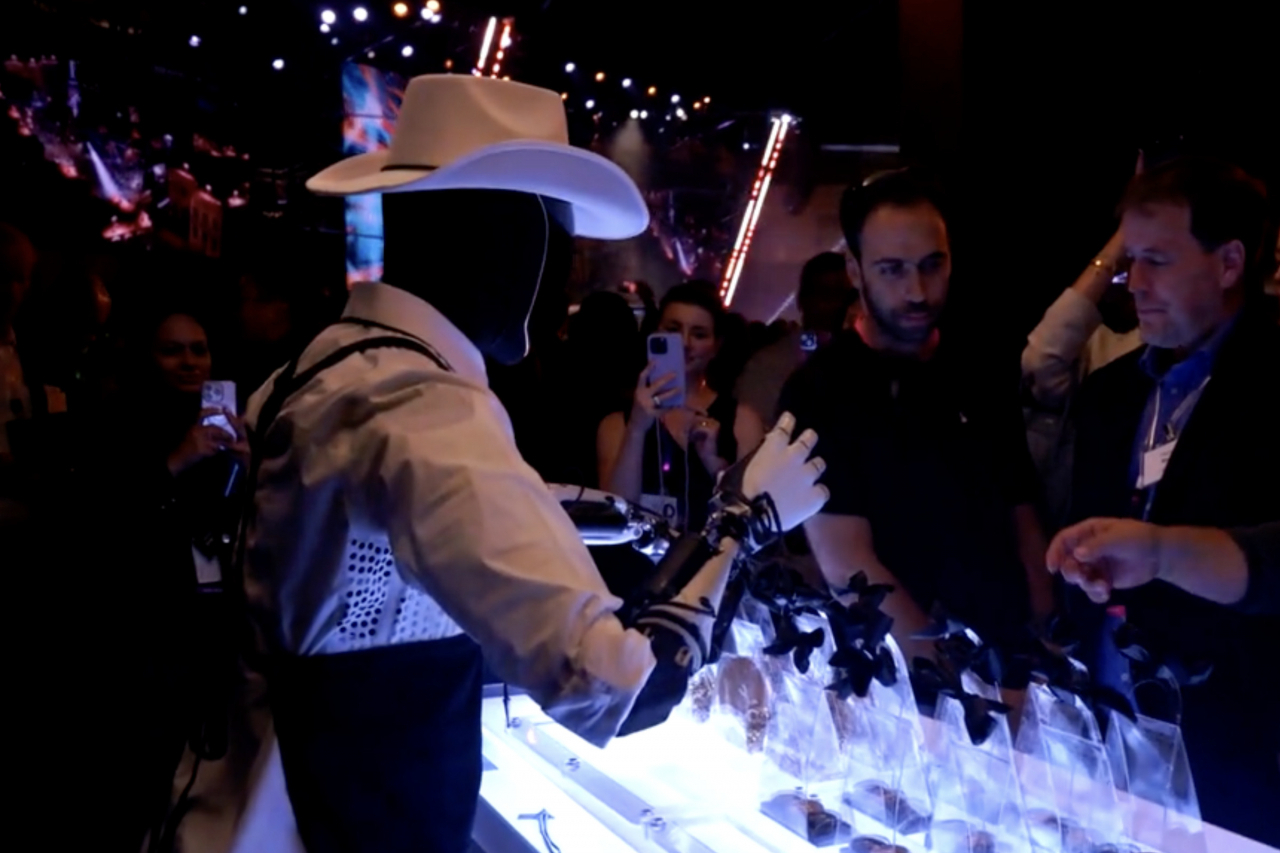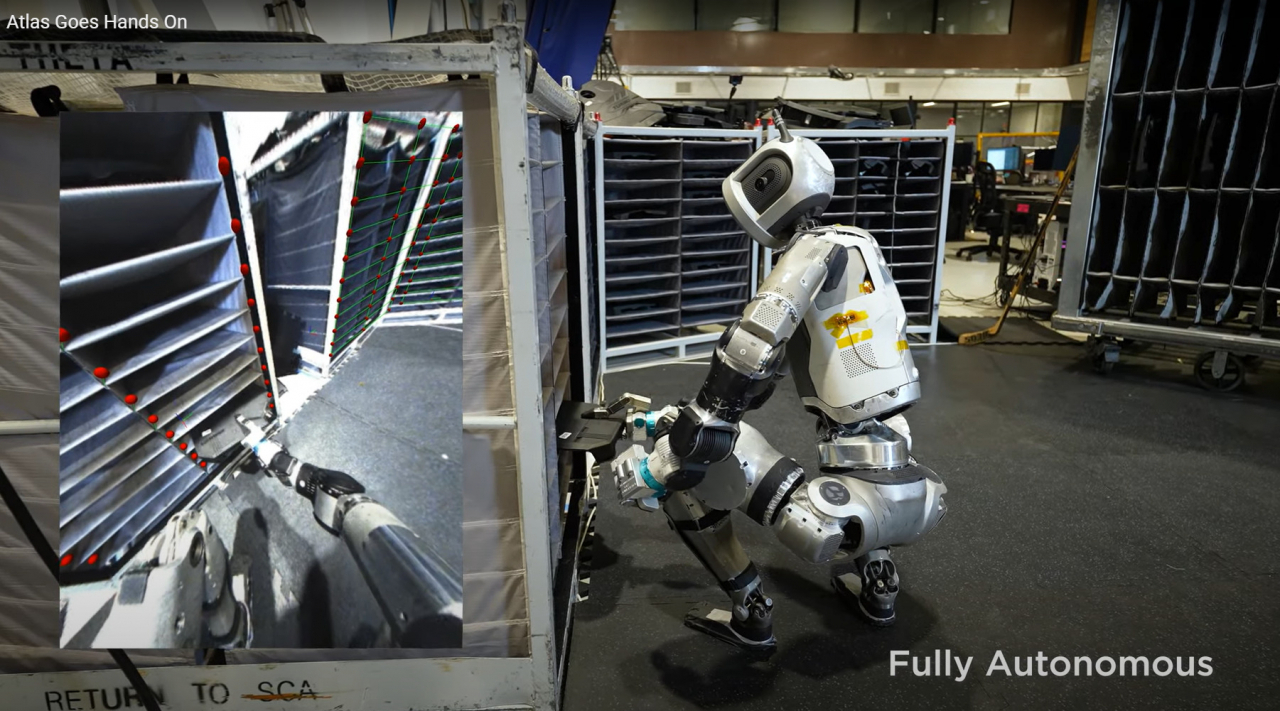 |
Boston Dynamics’ humanoid robot Atlas autonomously sorts engine cover parts using vision-based recognition in an automotive factory, as demonstrated in a video released by the company on Oct. 31. (Hyundai Motor Group) |
Hyundai-owned Boston Dynamics has been making headlines with the latest developments in its humanoid robot, Atlas. In recent promotional videos, the all-electric version of Atlas is shown performing complex tasks in a simulated factory environment, suggesting that the company may be closer than ever to deploying humanoid robots in industrial settings.
This unveiling comes about a month after Tesla demonstrated its own humanoid robot, Optimus, at the company's "We, Robot" event, while reports later surfaced that Optimus was largely controlled by human operators during the presentation.
Tesla's Optimus demo raises eyebrows
On Oct. 10, Tesla introduced the second generation of its Optimus humanoid robot. The event showcased Optimus’ improved mobility and dexterity, including a new hand design that allows for finer manipulation. However, it has since been reported that Optimus was remotely operated during much of the demonstration, raising questions about its readiness for autonomous factory work.
 |
Tesla’s Optimus robot, wearing a cowboy hat, performed tasks like serving drinks at the company's “We, Robot” event on Oct. 10, though reports suggest much of the spectacle was achieved with human assistance. (Tesla) |
Kang Hee-jin, an analyst at Samsung Securities, observed that there was zero mention of factory deployment timelines at Tesla’s event -- a notable omission given Elon Musk’s previous promises. Earlier this year, Musk had claimed Optimus would be ready for mass production and use in Tesla’s own factories by 2025, with a wider rollout by 2026.
"Investor reactions to the event were lukewarm. This absence of concrete plans suggests either that full autonomy is farther off than Tesla anticipated, or that humanoid robots may not be suited for industrial use in the near term," Kang said.
Rapid evolution of Atlas
Originally conceived for disaster response, Boston Dynamics’ Atlas has been continuously refined and is now demonstrating potential applications for industrial tasks. Unlike previous iterations that relied on complex hydraulic systems, the version of Atlas introduced earlier this year uses electric actuators, which simplify its design and potentially make mass production more feasible.
The shift to electric actuators, which involve a streamlined motor-reducer-inverter system, allows for better modularization and precise control. This design change also offers cost advantages, as it enables standardization across multiple joint components. Tesla adopted electric actuators for Optimus earlier on, standardizing 28 actuators down to just six types, which aids in production scalability.
 |
(Hyundai Motor Group) |
In Boston Dynamics' recent video, the latest Atlas is shown autonomously sorting objects in a simulated factory setting. Using a new machine-learning-based vision model, the robot can recognize parts, determine the correct grip points, and place items in designated compartments. Atlas also demonstrates the ability to learn from mistakes. When it encounters an error -- such as getting an object stuck in a compartment -- it adjusts its actions and resumes work without human intervention.
An official from Boston Dynamics emphasized that these actions were performed without remote control.
Outlets like The New York Post praised Atlas’s ability to complete tasks with no human control, highlighting its advanced spatial awareness and autonomous decision-making. In IEEE Spectrum and TechRadar, Atlas was described as both “autonomous and productive,” with TechRadar calling it “the scariest video of Halloween” due to its lifelike adaptability.
Tesla's supremacy in data
Despite Boston Dynamics' technical progress, Tesla’s experience with scalable production and extensive data may still give it an edge. Professor Jeon Jin-woo, a senior researcher at the Korea Institute for Robot Industry Advancement, explained that Tesla’s focus on data-driven learning sets Optimus apart. “Optimus mimics human motions based on data collected from Tesla’s factory operations, which allows it to replicate real-world behaviors. Boston Dynamics’ Atlas, by contrast, appears to prioritize robotic-specific motions rather than directly imitating humans.”
Jeon suggested that this distinction could present challenges for Atlas in a factory environment. “Because Atlas’s movements don’t precisely mimic human actions, the robot maker might need to invest additional time and resources to adapt human workflows to suit the robot’s capabilities. In comparison, Tesla’s approach -- using AI to emulate the actions of human workers -- could make Optimus more adaptable to existing assembly lines.”
Tesla’s established manufacturing infrastructure may also be an advantage. "Boston Dynamics is making strides, but Tesla is far ahead in terms of rapid prototyping, modular design, and high-volume production," Jeon noted. “Tesla has spent years refining autonomous systems and flexible production lines for electric vehicles, which could accelerate the path to a factory-ready robot. Boston Dynamics, even with Hyundai’s backing, will likely face challenges in building similar capacity in the short term.”
Tough path to market readiness
Both companies are betting on a future where humanoid robots play a key role in manufacturing, but the path forward is uncertain. Tesla has announced a potential price range of $20,000 to $30,000 for Optimus, though it has yet to clarify specific industrial applications.
Kang from Samsung Securities posited that the market for humanoid robots will only grow if manufacturers can clearly define their purpose. "Tesla doesn’t need to compete solely on price if it can demonstrate unique value. But without a clear application, it’s hard for investors to assess Optimus’ potential.”
Boston Dynamics, meanwhile, appears to be moving cautiously. The new electric Atlas may be more practical than its predecessors, but the company has not yet revealed a timeline for commercial deployment.







![[Weekender] Korea's traditional sauce culture gains global recognition](http://res.heraldm.com/phpwas/restmb_idxmake.php?idx=644&simg=/content/image/2024/11/21/20241121050153_0.jpg)